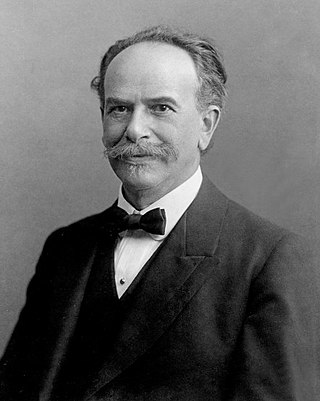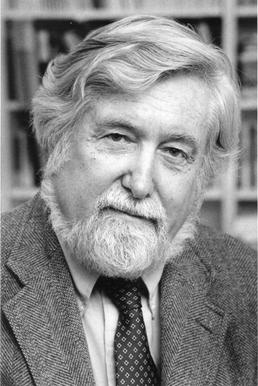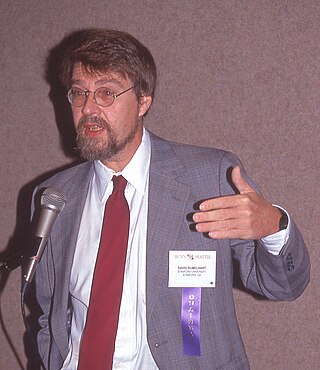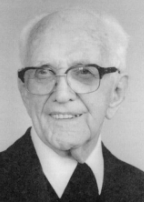Related Research Articles

Anthropology is the scientific study of humanity, concerned with human behavior, human biology, cultures, societies, and linguistics, in both the present and past, including archaic humans. Social anthropology studies patterns of behavior, while cultural anthropology studies cultural meaning, including norms and values. The term sociocultural anthropology is commonly used today. Linguistic anthropology studies how language influences social life. Biological or physical anthropology studies the biological development of humans.

Cultural anthropology is a branch of anthropology focused on the study of cultural variation among humans. It is in contrast to social anthropology, which perceives cultural variation as a subset of a posited anthropological constant. The term sociocultural anthropology includes both cultural and social anthropology traditions.

Franz Uri Boas was a German-American anthropologist and ethnomusicologist. He was a pioneer of modern anthropology who has been called the "Father of American Anthropology". His work is associated with the movements known as historical particularism and cultural relativism.
Race is a categorization of humans based on shared physical or social qualities into groups generally viewed as distinct within a given society. The term came into common usage during the 16th century, when it was used to refer to groups of various kinds, including those characterized by close kinship relations. By the 17th century, the term began to refer to physical (phenotypical) traits, and then later to national affiliations. Modern science regards race as a social construct, an identity which is assigned based on rules made by society. While partly based on physical similarities within groups, race does not have an inherent physical or biological meaning. The concept of race is foundational to racism, the belief that humans can be divided based on the superiority of one race over another.
Medical anthropology studies "human health and disease, health care systems, and biocultural adaptation". It views humans from multidimensional and ecological perspectives. It is one of the most highly developed areas of anthropology and applied anthropology, and is a subfield of social and cultural anthropology that examines the ways in which culture and society are organized around or influenced by issues of health, health care and related issues.

Clifford James Geertz was an American anthropologist who is remembered mostly for his strong support for and influence on the practice of symbolic anthropology and who was considered "for three decades... the single most influential cultural anthropologist in the United States." He served until his death as professor emeritus at the Institute for Advanced Study, Princeton.

Material culture is the aspect of culture manifested by the physical objects and architecture of a society. The term is primarily used in archaeology and anthropology, but is also of interest to sociology, geography and history. The field considers artifacts in relation to their specific cultural and historic contexts, communities and belief systems. It includes the usage, consumption, creation and trade of objects as well as the behaviors, norms and rituals that the objects create or take part in.

David Everett Rumelhart was an American psychologist who made many contributions to the formal analysis of human cognition, working primarily within the frameworks of mathematical psychology, symbolic artificial intelligence, and parallel distributed processing. He also admired formal linguistic approaches to cognition, and explored the possibility of formulating a formal grammar to capture the structure of stories.
Gloria Jean Ladson-Billings FBA is an American pedagogical theorist and teacher educator known for her work in the fields of culturally relevant pedagogy and critical race theory, and the pernicious effects of systemic racism and economic inequality on educational opportunities. Her book The Dreamkeepers: Successful Teachers of African-American Children is a significant text in the field of education. Ladson-Billings is Professor Emerita and formerly the Kellner Family Distinguished Professor of Urban Education in the Department of Curriculum and Instruction at the University of Wisconsin–Madison.
George Woodman Hilton was a United States historian and economist, who specialized in social history, transportation economics, regulation by commission, the history of economic thought and labor history.
Ray L. Birdwhistell was an American anthropologist who founded kinesics as a field of inquiry and research. Birdwhistell coined the term kinesics, meaning "facial expression, gestures, posture and gait, and visible arm and body movements". He estimated that "no more than 30 to 35 percent of the social meaning of a conversation or an interaction is carried by the words." Stated more broadly, he argued that "words are not the only containers of social knowledge." He proposed other technical terms, including kineme, and many others less frequently used today. Birdwhistell had at least as much impact on the study of language and social interaction generally as just nonverbal communication because he was interested in the study of communication more broadly than is often recognized. Birdwhistell understood body movements to be culturally patterned rather than universal. His students were required to read widely, sources not only in communication but also anthropology and linguistics. "Birdwhistell himself was deeply disappointed that his general communicative interests and goals were not appropriately understood." Collaborations with others, including initially Margaret Mead and Gregory Bateson, and later, Erving Goffman and Dell Hymes had huge influence on his work. For example, the book he is best known for, Kinesics and Context, "would not have appeared if it had not been envisaged by Erving Goffman" and he explicitly stated "the paramount and sustaining influence upon my work has been that of anthropological linguistics", a tradition most directly represented at the University of Pennsylvania by Hymes.

Educational anthropology, or the anthropology of education, is a sub-field of socio-cultural anthropology that focuses on the role that culture has in education, as well as how social processes and cultural relations are shaped by educational settings. To do so, educational anthropologists focus on education and multiculturalism, educational pluralism, culturally relevant pedagogy and native methods of learning and socializing. Educational anthropologists are also interested in the education of marginal and peripheral communities within large nation states. Overall, educational anthropology tends to be considered as an applied field, as the focus of educational anthropology is on improving teaching learning process within classroom settings.
William Spindler is a Guatemalan writer and journalist, whose works include fiction, poetry, and journalism in English and Spanish. He is the author of a novel Paises lejanos, and a book of short stories, "Expediciones", published in Bogota, Colombia in 2004. He was educated at the Liceo Guatemala school where he obtained a Bachillerato en Ciencias y Letras in September 1980. He completed his further education in London, UK after his family moved there in 1981. In 1988 he graduated from the Polytechnic of the South Bank in London with an Honours Bachelor of Arts in Modern Languages and International Studies.
Beatrice Medicine was a scholar, anthropologist, and educator known for her work in the fields of Indigenous languages, cultures, and history. Medicine spent much of her life researching, teaching, and serving Native communities, primarily in the fields of bilingual education, addiction and recovery, mental health, tribal identity, and women's, children's, and LGBT community issues.

Woman, Culture, and Society, first published in 1974, is a book consisting of 16 papers contributed by female authors and an introduction by the editors Michelle Zimbalist Rosaldo and Louise Lamphere. On the heels of the 1960s feminist movement, this book challenged anthropology's status quo of viewing studied cultures from a male perspective while diminishing female perspectives, even considering women as comparatively imperceptible. It is considered to be a pioneering work.
Marie Margaret Keesing was an anthropologist and educator with strong ties to the Pacific. With a degree in anthropology from the University of New Zealand, she spent most of her working life in the United States, where she worked closely with her husband, a fellow New Zealander and renowned anthropologist Felix Maxwell Keesing. She published a number of works, and co-authored several significant books with her husband, including Taming Philippine Headhunters: a Study of Government and of Cultural Change in Northern Luzon (1934) and Elite Communication in Samoa: A Study of Leadership (1956).
Felix M. Keesing was a New Zealand-born anthropologist who specialized in the study of the Philippine Islands and the South Pacific. He came to the United States in the 1940s and taught at Stanford University, California, 1942–1961.
Francis L. K. Hsu was a China-born American anthropologist, one of the founders of psychological anthropology. He was president of the American Anthropological Association from 1977 to 1978.

Stephen Fuchs was an Austrian Catholic priest, missionary, and anthropologist who researched the ethnology and prehistory of India. After obtaining a Ph.D. in ethnology and Indology from the University of Vienna in 1950, Fuchs moved to India where he assisted in founding the Department of Anthropology at St. Xavier's College in Bombay. After a brief imprisonment for being misidentified as a German missionary by the British government during World War II, Fuchs founded the Indian Branch of the Anthropos Institute, later renamed the Institute of Indian Culture. Fuchs, because of health concerns, moved to Austria in 1996 and died at the age of 91 in Mödling, Austria.
Mary Louise Schaubel Spindler (1917–1997), known professionally as Louise S. Spindler, was an American anthropologist, author, and scholar. Working with her husband and collaborator, George Spindler, she primarily studied the Menominee tribe in Wisconsin and helped revolutionize the field of educational anthropology. She is the sole author of two monographs and four book chapters, as well as the co-author and editor of over 40 books and book chapters and 224 case studies. She was a professor in the anthropology department at Stanford University for nearly fifty years until she died on January 23, 1997 at the age of 80.
References
- 1 2 Trueba, Enrique T. (2004). The new Americans. Rowman & Littlefield. p. 119. ISBN 978-0-7425-2884-0.
- ↑ McDermott, Ray (June 2008). "Reading George Spindler". Anthropology & Education Quarterly. 39 (2). Blackwell Publishing: 117–126. doi:10.1111/j.1548-1492.2008.00011.x.
- 1 2 McDermott, Ray; Stockard, Janice E.; Erickson, Frederick (2014). "IN MEMORIAM: George Dearborn Spindler 1920-2014". Journal of American Indian Education. 53 (2): 4–6. doi:10.1353/jaie.2014.a798517. ISSN 2379-3651.
- 1 2 Turan, Julia. "George Spindler, Stanford professor emeritus of anthropology and education, has died at 94". news.stanford.edu. Retrieved 16 August 2017.
- 1 2 Spindler, George D. (October 2000). "The Four Careers of George and Louise Spindler: 1948-2000". Annual Review of Anthropology. 29 (1): xv–xxxviii. doi:10.1146/annurev.anthro.29.1.00. ISSN 0084-6570 . Retrieved 27 March 2023.
- ↑ "Special Publications of the AAA: A Brief History". Aaanet.org. 2011-07-27. Archived from the original on 2012-09-22. Retrieved 2012-08-13.